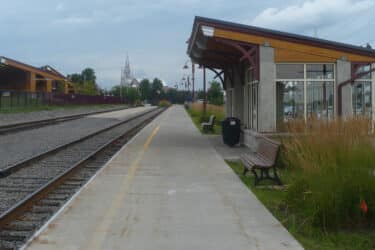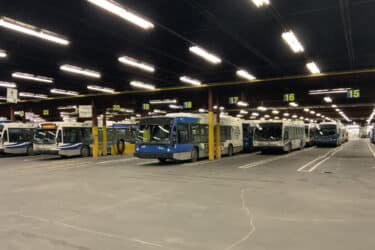In 2015, the Government of Quebec mandated Caisse de dépôt et placement du Québec (CDPQ), the Quebec pension fund manager, to assess the feasibility and, if such feasibility demonstrated, to procure a new 67-km automated driverless light metro system linking downtown Montreal, South Shore (using the future new Champlain Bridge), West Island, North Shore and the airport.
Once completed, the REM (Réseau électrique métropolitain) will be the fourth-largest automated transportation system in the world, after Singapore (82 km), Dubai (80 km) and Vancouver (68 km). For the Montreal Metropolitan Area, the REM represents the largest public transportation infrastructure since the metro of Montreal, inaugurated in 1966. Combined with existing transportation networks (metro, trains and buses), the REM opens a new era of public transit development in the Greater Montreal area.
As part of a pool of an integrated team of four consultancy firms (in association with Hatch), the SYSTRA team was appointed, in December 2015, to advise CDPQ.
Concept Validation
The first phase of our services consisted in carrying out the validation of the client’s vision. Thus, the procurement initially envisaged two stand-alone, fully greenfield projects (one system linking the south shore to the downtown area and the another linking the downtown area to the airport only). Once appointed, CDPQ required that a different approach be assessed, consisting of one integrated-linked system and using/converting the existing Agence métropolitaine de transport (AMT)’s Deux Montagnes commuter rail line (heavy rail type). Under this phase, the SYSTRA team carried out several technical feasibility assessments, including power supply and operation simulations.
PREliminary Design and Preparation of Technical Specifications
The system is currently procured under two main packages: (i) Civil Work package and (ii) Rolling Stock, O&M and Systems package. Shortlisted firms/consortia have been selected and an RFP is due shortly.
SYSTRA Canada/SYSTRA’s experts wrote the technical requirements of the tender documents, including those for:
- Signalling based on CBTC solution, interlocking and Automatic Train Supervision systems;
- Reliability, Availability, Maintainability and Safety (RAMS);
- Integration system and interfaces management;
- Rolling stock;
- Telecommunication system;
- Power supply, including EMC/EMI;
- Operation & maintenance;
- Urban and architectural design of the stations (BIM);
- Operating control center;
- Platform screen door;
- SCADA.
The major difficulty of this project is the line conversion (i.e. migration) and the integration of the new system. The migration is complex because the new systems must be installed with the least impact on operation. The integration of the signalling, rolling stock and supervision system requires a subtle analysis of the interfaces between the new subsystems and existing subsystems. Since the REM project encompasses a greenfield and a brownfield area (32 km), the goal thru the tender documents is to force the contractor to ensure the operation in the brownfield area without disruption of the service line during the migration phases. Based on our successful experiences, we have studied that our solution was compliant with this strong constraint in terms of schedule, cost, feasibility and technical requirements.
SYSTRA Canada’s/SYSTRA’s experts accompanied CDPQ during the technical requirement definition process and participated to discussions with many of the project stakeholders.
Our experience is global (worldwide), various (contractors, suppliers, consultants) and successful (NYCT, Paris Metro Line 1). Furthermore, the contribution of our engineers coming from the RATP (Autonomous Operator of Parisian Transports), and working for their REM project, has proven very useful to support the client by defining the needs and the performance criteria for the tender documents.
SYSTRA Canada/SYSTRA brought to the REM project the expertise it has developed on other worldwide projects, namely in systems design, operations, maintenance and rolling stock. Its wide experience in acting as project engineer for the Owner, the contractor, the supplier or as an independent consultant, contributes to the success of projects, allowing their assessment from different angles, anticipating major difficulties and finding ways to circumvent them.
 Go Durham Electric Vehicle Charging Plan
Go Durham Electric Vehicle Charging Plan
 Safety Audit & Site Management of the REM
Safety Audit & Site Management of the REM
 Feasibility & Preliminary Studies to Improve Accessibility at the Saint-Jérôme Station
Feasibility & Preliminary Studies to Improve Accessibility at the Saint-Jérôme Station
 Design, Construction & Financing of the Ontario Line South Civil
Design, Construction & Financing of the Ontario Line South Civil
 Phase IV of STL Garage Expansion
Phase IV of STL Garage Expansion
 Peer Review of REM de l’Est Ridership Forecasting
Peer Review of REM de l’Est Ridership Forecasting
 Australia
Australia  Brazil
Brazil  China
China  Denmark
Denmark  France
France  India
India  Indonesia
Indonesia  Ireland
Ireland  Italy
Italy  Malaysia
Malaysia  New Zealand
New Zealand  Norway
Norway  Poland
Poland  Saudi Arabia
Saudi Arabia  Singapore
Singapore  South Korea
South Korea  Sweden
Sweden  Thailand
Thailand  United Kingdom
United Kingdom  United States
United States  Taiwan
Taiwan  Vietnam
Vietnam